- Author Jason Gerald [email protected].
- Public 2023-12-16 10:50.
- Last modified 2025-01-23 12:04.
If your computer is suddenly full of advertisements or your web browser is always opening the wrong sites, it may be that your computer is infected with adware. Windows and Mac computers are vulnerable to attacks by malicious programs that can hijack your browser and fill your computer screen with advertisements. If your computer is not protected with a security program and has become infected, you could lose all the data on it. Fortunately, many internet security experts share various methods for dealing with malicious coders. They show you various ways you can manually remove adware when your computer is infected.
Step
Method 1 of 2: Removing Adware on Windows Computer

Step 1. Boot into Safe Mode with Networking Support
Remove all removable media (such as CDs and flash disks / USB flash drives), then restart the computer into Safe Mode.
-
Windows 8 and 10:
- Press Win+X, select the option " Shut down or Sign Out ", then select " Restart ".
- When the computer boots to the login screen, press and hold the Shift key while clicking the Power icon. The computer will restart again.
- When the boot screen is displayed again, click " Troubleshoot " → " Advanced Options " → " Startup Settings " → " Restart ".
- In the boot options screen that appears, press the button next to "Safe Mode with Networking" (you can either F5 or 5, depending on the computer you're using).
- Windows 7 and earlier: Click Start, then click the arrow next to " Shut Down ". Click Restart. After the computer shuts down and restarts, keep tapping the F8 key to open the boot menu. Use the directional buttons to select the "Safe Mode With Networking" option, then press Enter.
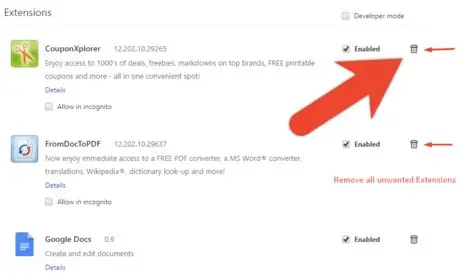
Step 2. Open a web browser to check for any malicious extensions or add-ons
Adware often attacks computers in the form of extensions or add-ons in web browsers.
- Chrome: Click the Chrome menu (which is in the top-right corner of the browser, three horizontal lines), then select "Settings". Select " Extensions ", then look for unknown extensions. If there is an unknown extension, click the trash icon to delete it.
- Internet Explorer: Select "Tools" → "Manage add-ons". To see a list of all installed extensions, click "All add-ons". Select an unknown extension, then click "Disable". Click the " Close " button when you are finished.
- Firefox: Check the add-ons installed in this browser by clicking Open (three horizontal lines) in the upper-right corner of the screen, then selecting "Add-ons". Next, select " Extensions " and look for unknown extensions. Disable the extension by clicking on it once, then click the "Disable" option.
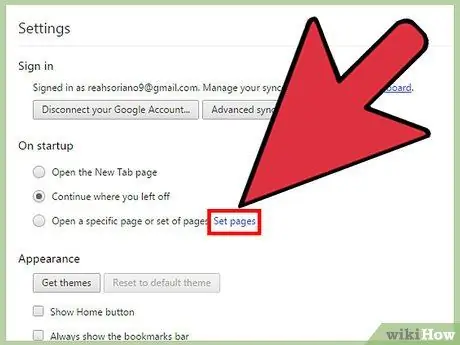
Step 3. Check your web browser start page, search engine and other defaults
Adware sometimes hijacks web pages and the default search engine in your browser.
-
Chrome: Click "Settings" in the Chrome menu, then select "Set Pages" (located under the "On Startup" section). If you see a web page that is not a blank page or one that you have set to open when you launch your browser, delete the site by selecting it in the list and pressing the X button.
- Make sure to bring up the Chrome button. Within the same Settings menu, find the Appearance section, and click "Show Home Button". Next, click "Change" and select "Use the New Tab Page". Save the changes you made by clicking " Ok ".
- Click " Manage Search Engines " under " Search " to verify the search engine settings in the Settings menu. Select the search engine you normally use, then select "Make default". Make sure the URL on the right side of the screen matches the name of the search engine you specified! If you see Yahoo.com on the left, but the URL on the right doesn't show search.yahoo.com, click the X on the screen to delete the URL.
-
Internet Explorer: Click "Tools" → "Manage Add-ons". Click "Search Providers" from the list, then select a search engine you recognize and use (eg Google, Bing, etc.). If something appears that you do not recognize, select the search engine, then click "Remove".
- Go back to Tools → " Internet Options ", then look at the " Home Page ". The URL in the box is your browser's default page. If you don't recognize it, delete the page, then select "Use new tab".
-
Look for the Internet Explorer icon on the desktop (or wherever you normally use to launch your browser by double-clicking the icon). Click the icon with the right mouse button, then select "Properties". Click the " Shortcut " tab, then check the column labeled " Target ". If there is text after writing
iexplore.exe
- , delete the text (but don't delete iexplore.exe). Click "OK".
-
Firefox: in the Open menu, click "Options", then select "Restore to Default". To continue, click OK.
Verify the search engine settings by clicking Open and selecting " Options ". In the left-hand bar, click " Search ", then set the default search engine to something reputable, such as Bing or Google. If something unknown appears under " One-click search engines ", click the search engine once, then click " Remove"
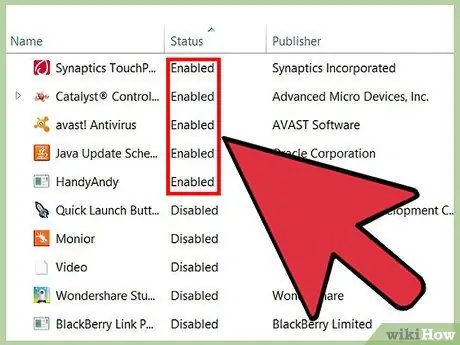
Step 4. Check which programs are running automatically
Open the search field by pressing Win+S key. Open the System Configuration panel by typing
msconfig
into that column. When its name appears in the search results, click the file. When you are asked to confirm, select "Yes" or "OK".
- Select the Startup tab to see a list of all the programs that run when the computer boots (Windows 8 and 10 users will be directed to the Task Manager, but the next steps will be the same).
- Go through the list and check for anything that looks like adware. It's a good idea to search the internet for information about the names of programs you don't recognize on an uninfected computer. Some names may look convincing, but they are not, and vice versa. In addition to the name of the program, there will be shown the company that made it. The companies listed there can help you find out which startup programs are harmless. You can disable unknown programs by removing the check mark from the box next to it (if you're running Windows 8 or 10, click the program you want to disable, then click "Disable").
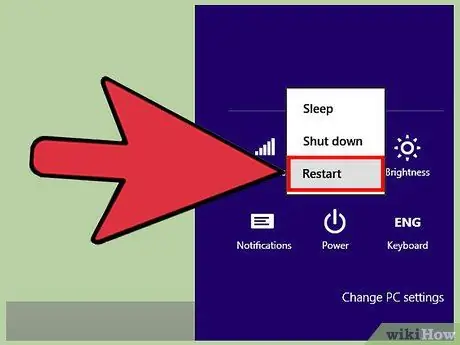
Step 5. Save the settings you set and restart the computer
If you are running Windows 7 or earlier, click " Apply ", then " OK ". If you are running Windows 8 or later, close the Task Manager window by clicking the X.
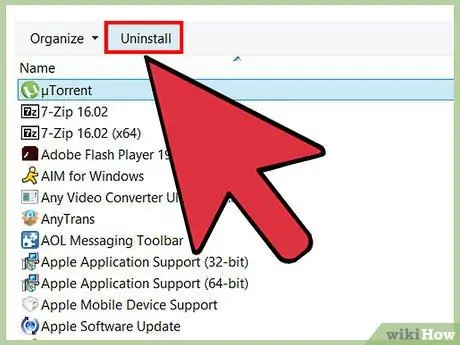
Step 6. Check if there are any programs that cannot be uninstalled
If you still see pop-ups on your computer or annoying advertisements appear when your computer reboots, check to see if there are any programs that can't be removed with the regular program removal feature. Open the search bar and type Programs, then click "Programs and Features".
- In the list of installed programs, look for an unknown program. You can sort the list by date of installation by clicking on the date at the top of the list.
- If you want to remove a program, click the program once, then click "Uninstall". Restart the computer after you remove the software.
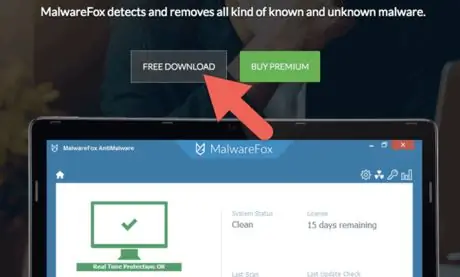
Step 7. Download MalwareFox Anti-Malware
If the adware can't be found or removed using the described manual steps, it's time for you to use the ultimate weapon. A proven solution is to use MalwareFox which can be downloaded by visiting the site and clicking " Free Download ". Start the download by selecting "Download Free Version", then save your download to the desktop when prompted.
If you can't download any programs, download MalwareFox Anti-Malware on another computer, then save the file to a flash drive or CD/DVD. Insert the flash disk or CD/DVD into the infected computer. Press Win+E key to open File Explorer (with the flash drive or CD/DVD still in the computer), then double-click the flash drive or CD/DVD which is on the left side of the screen
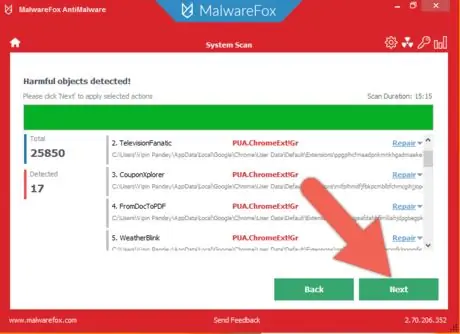
Step 8. Run Anti-Malware and perform a scan
Double click the file you downloaded to run it, then click " Scan ". When the scanner in the program finds adware, the color of its interface will turn red. You can remove the adware by clicking "Next". If there is adware that cannot be removed (this is a rare case, but it can happen), note the name of the adware and proceed.
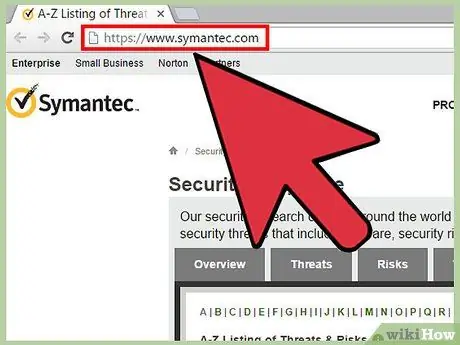
Step 9. Look for instructions from Symantec to remove the adware
Use Safe Mode or another computer to visit Symantec's list of Malware from A to Z. This constantly updated site provides links with instructions for removing almost every type of adware that exists. Select the first letter of the name of the adware that attacked your computer and scroll down until you find it. Click the name of the adware.
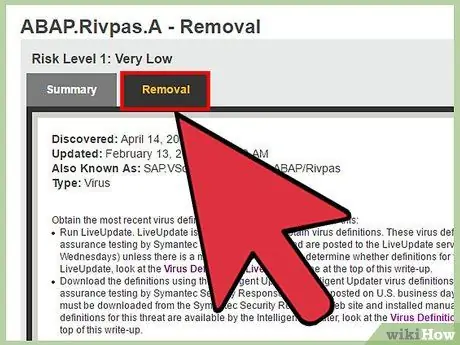
Step 10. Click "Removal" to see the instructions
The first set of instructions is intended for users of Symantec's security programs. If you are not a user of their program, skip to the second step and follow the instructions given to remove the adware. Each adware requires different treatment. Some adware is more difficult to remove than others. Restart the computer when you have finished carrying out all the instructions given according to the adware that infected your computer.
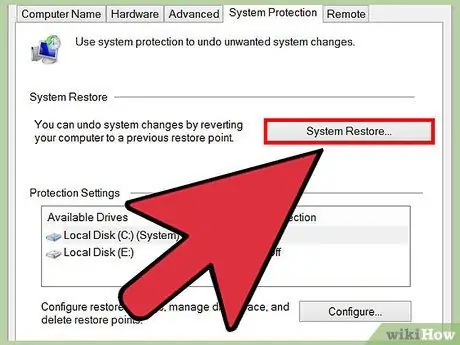
Step 11. Run System Restore
No matter you succeed or fail in removing the adware, run System Restore to restore the computer to a date when it was still functioning properly.
Method 2 of 2: Removing Adware on Mac Computer
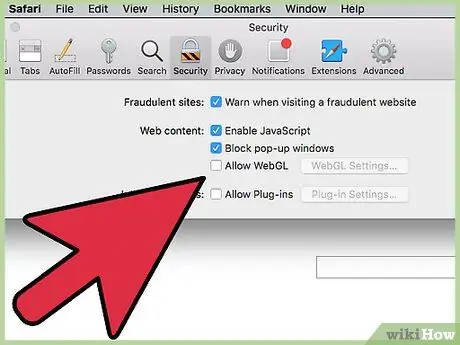
Step 1. Block pop-up windows in web browsers
This is an important step so that you can complete this method without getting too much hassle.
- Safari: On the "Safari" menu, select "Preferences" → "Security" → "Block pop-up windows". Then deselect "Allow WebGL" and "Allow Plugins".
- Chrome: On the Chrome menu (three horizontal lines), select "Settings", then scroll down and click "Show advanced settings". Select "Privacy", click "Content Settings", then select "Do not allow any site to show pop-ups".
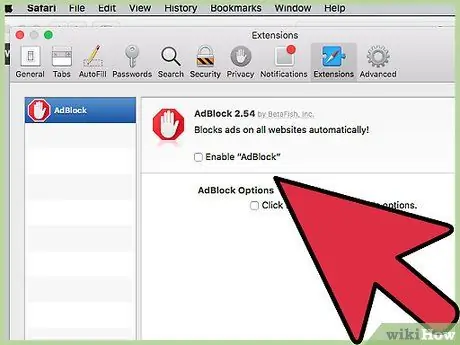
Step 2. Check your web browser settings for malicious search engines and extensions
- Safari: In the Safari menu, select "Preferences" → "Extensions". If there is an unknown program, click the "Uninstall" button. Next, click the "General" tab and make sure the default search engine in the web browser is set to a known search engine. If not, assign it to the search engine you normally use. Safari does install some built-in programs into the software. A safe option is to set Google as the default search engine.
-
Chrome: In the Chrome menu, select "Settings" → "Extensions". Click the trash icon next to the unknown extension. Next, click "Settings" in the left menu and scroll down to "Advanced Settings" and follow the link.
- Scroll down to " On Startup ", and make sure you have selected " Open the New Tab page ".
- Scroll down to " Search ", then click " Manage Search Engines ". Make sure you recognize all the search engines shown in the top box. Pay close attention to the URL on the right, as many adware programs will trick you into pretending to be Google when you will be redirected to another site. Remove anything suspicious by clicking the X next to the site.
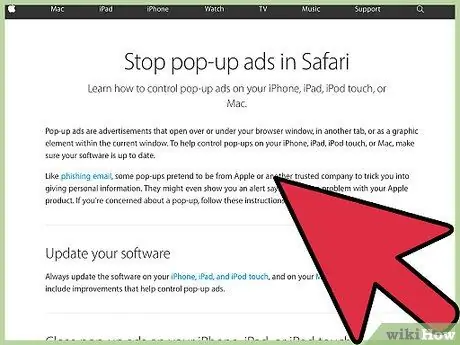
Step 3. Download Apple Support article HT203987 in PDF format
The next step requires you to close your browser. So, save the site to your computer. Visit https://support.apple.com/en-us/HT203987. Once the site is loaded, click " File " → " Print " → " Save as PDF ". Set the Desktop as a storage place so that files can be found easily and quickly.
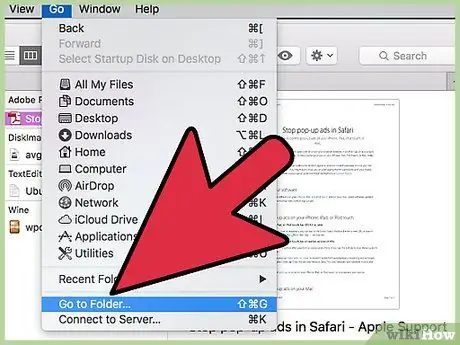
Step 4. Use the "Go to Folder" method to search for adware
Familiarize yourself with this method as you will be using it a lot.
-
Open the newly created PDF file, then scroll down to the list of files located in the
/System/Library/Frameworks/v.framework
- . Highlight the first line in the list of files (this is the file used in the example), then select " Edit " and click " Copy ".
- Run Finder and select " View " → " As Columns ". Next, click "Go" → "Go to Folder".
- Click " Edit " → " Paste " to paste the file you have highlighted into the box. Press Return key to search for the file. Once found, drag the file to the Trash. If not found, copy the next file in the PDF list and do the same.
- Repeat this "Go to Method" for each file in the list. When you are finished, empty the Trash by clicking " Finder " → " Empty Trash ". Restart your computer.
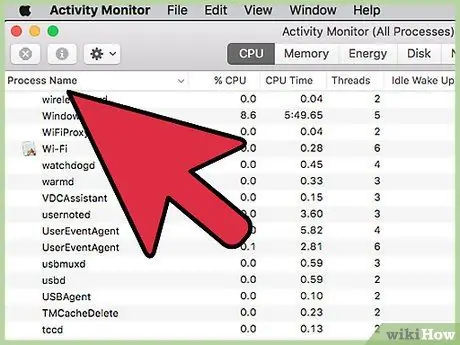
Step 5. Check if any other adware is running
When the computer restarts and the adware is still there, launch Finder, select " Applications ", then click " Utilities " and select " Activity Monitor ". In the CPU tab, click " Process Name " to sort the column alphabetically and look for a process named " InstallMac " or " Genieo ".
-
If there are still programs running in Activity Monitor, repeat the "Go to Folder" process with the following text:
/private/etc/launchd.conf
- . When finished, restart your computer.
- Go back to the PDF file from Apple and scroll down to " Remove Genieo, InstallMac ", then repeat the process for each file under " Restart your Mac ". Restart the computer when you have completed each file process and dragged the necessary files to the Trash.
-
Use " Go to Folder " after the computer restarts. This time navigate to file
/Library/Frameworks/GenieoExtra.framework
- . Empty the Trash (which is in the Finder).
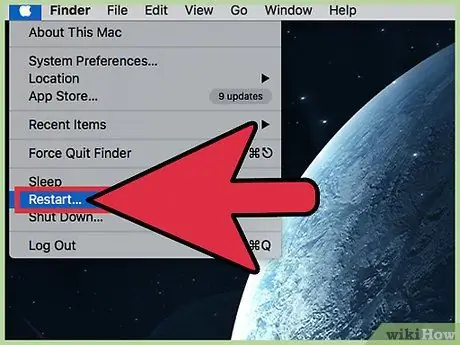
Step 6. Restart the computer
Now your computer will be free of adware. If your computer is still infected with adware when you restart it, you will need to install an Adware removal tool.
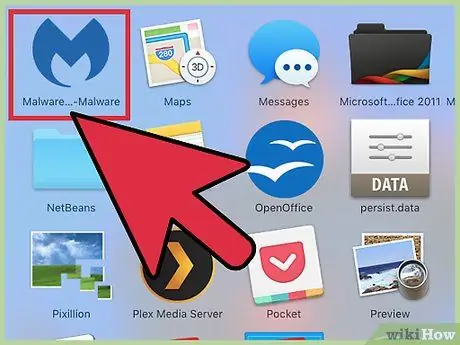
Step 7. Download and install Malwarebytes Anti-Malware for Mac
Malwarebytes is a powerful program for removing adware at home. Click " Download " and select a place to save the file. Once it's finished downloading, double-click the file to run it.
- If the presence of adware prevents you from downloading Anti-Malware, use a different computer to download the installer and save the files to a flash drive or CD/DVD.
- When you run "Anti-Malware for Mac" for the first time, you may be asked if you really want to open it. Select "Open". If another message appears regarding your computer's security preferences, click the Apple menu and select "System Preferences", then "Security and Privacy". In the General tab, select "Open Anyway" to run this software.
- The first time you run Anti-Malware, you will be prompted to enter a username and password for the administrator account. Type and click "Install Helper".
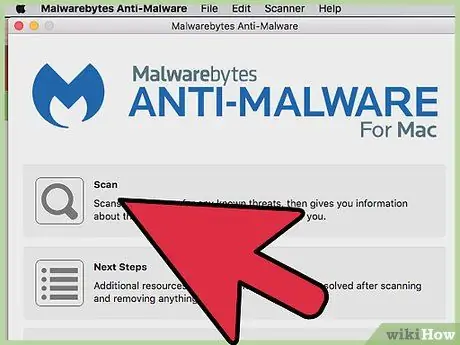
Step 8. Click the "Scan" button
If any adware is found, the program will list it after the scan is complete. Click the name of the adware that attacked the computer, then select "Remove selected items" to remove it. Restart your computer, and the adware will definitely be gone.
Tips
- Never download programs from untrusted sites.
- Update the antivirus/anti-malware program on your computer as often as possible.
- Protect your computer from all forms of malware using an antivirus program.
- Save the Malwarebytes Anti-Malware program on a flash drive or CD/DVD just in case you encounter an emergency.
Warning
- Take your computer to a professional for repair if all of the above methods don't work.
- Adware often gets onto computers when users see a pop-up message on the monitor that says something like " Warning! Your computer is infected!" (Warning! Your computer is infected!). A reputable anti-malware program will not send messages in web browsers. The original warning will appear in a different window with the name of the anti-malware program at the top, or in the form of a pop-up notification on the Windows taskbar.






